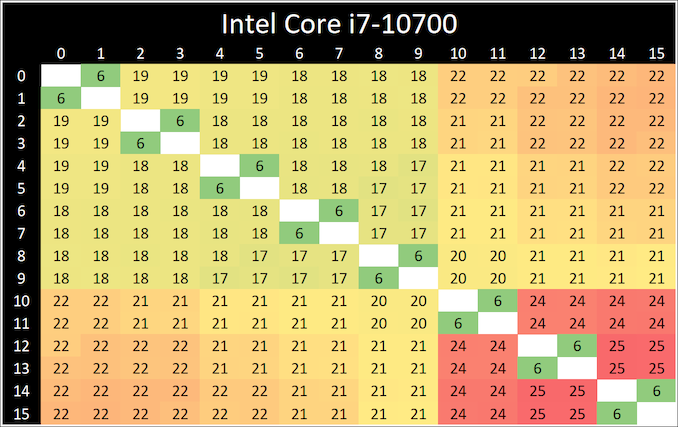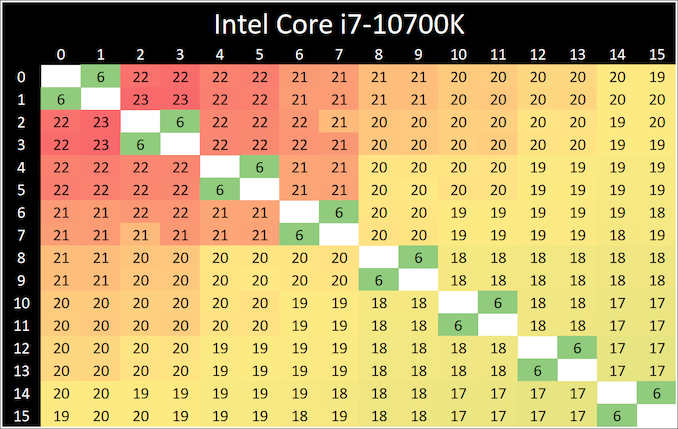Intel Core i7-10700 vs Core i7-10700K Review: Is 65W Comet Lake an Option?
by Dr. Ian Cutress on January 21, 2021 10:30 AM EST- Posted in
- CPUs
- Intel
- Core i7
- Z490
- 10th Gen Core
- Comet Lake
- i7-10700K
- i7-10700
CPU Tests: Microbenchmarks
Core-to-Core Latency
As the core count of modern CPUs is growing, we are reaching a time when the time to access each core from a different core is no longer a constant. Even before the advent of heterogeneous SoC designs, processors built on large rings or meshes can have different latencies to access the nearest core compared to the furthest core. This rings true especially in multi-socket server environments.
But modern CPUs, even desktop and consumer CPUs, can have variable access latency to get to another core. For example, in the first generation Threadripper CPUs, we had four chips on the package, each with 8 threads, and each with a different core-to-core latency depending on if it was on-die or off-die. This gets more complex with products like Lakefield, which has two different communication buses depending on which core is talking to which.
If you are a regular reader of AnandTech’s CPU reviews, you will recognize our Core-to-Core latency test. It’s a great way to show exactly how groups of cores are laid out on the silicon. This is a custom in-house test built by Andrei, and we know there are competing tests out there, but we feel ours is the most accurate to how quick an access between two cores can happen.
When we first reviewed the 10-core Comet Lake processors, we noticed that a core (or two) seemed to take slightly longer to ping/pong than the others. These two parts are both derived from the 10-core silicon but with two cores disabled, and we still see a pattern of some cores having additional latency. The ring on the 8-core parts still acts like a 10-core ring, but it all depends on which cores were disabled.
Frequency Ramping
Both AMD and Intel over the past few years have introduced features to their processors that speed up the time from when a CPU moves from idle into a high powered state. The effect of this means that users can get peak performance quicker, but the biggest knock-on effect for this is with battery life in mobile devices, especially if a system can turbo up quick and turbo down quick, ensuring that it stays in the lowest and most efficient power state for as long as possible.
Intel’s technology is called SpeedShift, although SpeedShift was not enabled until Skylake.
One of the issues though with this technology is that sometimes the adjustments in frequency can be so fast, software cannot detect them. If the frequency is changing on the order of microseconds, but your software is only probing frequency in milliseconds (or seconds), then quick changes will be missed. Not only that, as an observer probing the frequency, you could be affecting the actual turbo performance. When the CPU is changing frequency, it essentially has to pause all compute while it aligns the frequency rate of the whole core.
We wrote an extensive review analysis piece on this, called ‘Reaching for Turbo: Aligning Perception with AMD’s Frequency Metrics’, due to an issue where users were not observing the peak turbo speeds for AMD’s processors.
We got around the issue by making the frequency probing the workload causing the turbo. The software is able to detect frequency adjustments on a microsecond scale, so we can see how well a system can get to those boost frequencies. Our Frequency Ramp tool has already been in use in a number of reviews.
Both processors ramp from idle to full turbo in about six milliseconds, well within a single frame of standard gaming.













210 Comments
View All Comments
alexane - Sunday, January 24, 2021 - link
easy job online from home. I have received exactly $20845 last month from this home job. Join now this job and start making extra cash online. salary8 . comMilaEaston - Tuesday, January 26, 2021 - link
easy job online from home. I have received exactly $20845 last month from this home job. Join now this job and start making extra cash online. salary8 . com
flyingpants265 - Friday, January 22, 2021 - link
Right. I'm not even sure why this is an issue. TDP stands for "thermal design power", it's how much power the chip uses, it's not debatable.etal2 - Thursday, January 21, 2021 - link
What I'm missing from this review is a benchmark running under intels recommended settings.From what I've seen often people see the 65w rating and go on to combine the i7-10700 with cheap B460/H470 motherboards and basic coolers.
Duraz0rz - Thursday, January 21, 2021 - link
The problem here is that the turbo limit is not enforced by the chip, but by the mobo. So even cheap B460/H470 boards can set that limit to be higher than Intel's recommendations if they choose to. And no one that would be buying these boards will necessarily care to dig into the BIOS and set the limits themselves.Cygni - Thursday, January 21, 2021 - link
Yes, they would. There are lots of (admittedly niche) applications where outright sustained performance is less important that bursty performance in a limited thermal envelope, either due to space or ventilations issues. HTPCs, home servers, small industry applications, etcSo yeah, i agree with the OP, I would have liked to have seen performance numbers at the "suggested" 65w PL1.
Calin - Friday, January 22, 2021 - link
I totally agree with your comment, but what you ask for is a different article.Performance numbers in a strictly power limited environment - from Intel and AMD both (although Intel will be unfairly penalized by being three or so lithography generations behind).
Spunjji - Friday, January 22, 2021 - link
"unfairly penalized"The product you test is the product they have on sale - that's not unfair in the context of a test designed to represent a specific real-world requirement.
olde94 - Monday, January 25, 2021 - link
yeah i never heard anyone saing that amd was "unfairly penalized" in 2015. they could just "suck it up"Spunjji - Monday, January 25, 2021 - link
To be fair, some people did (GloFo's 28nm is terrible, I don't care about power, etc.) and I had no time for them either.